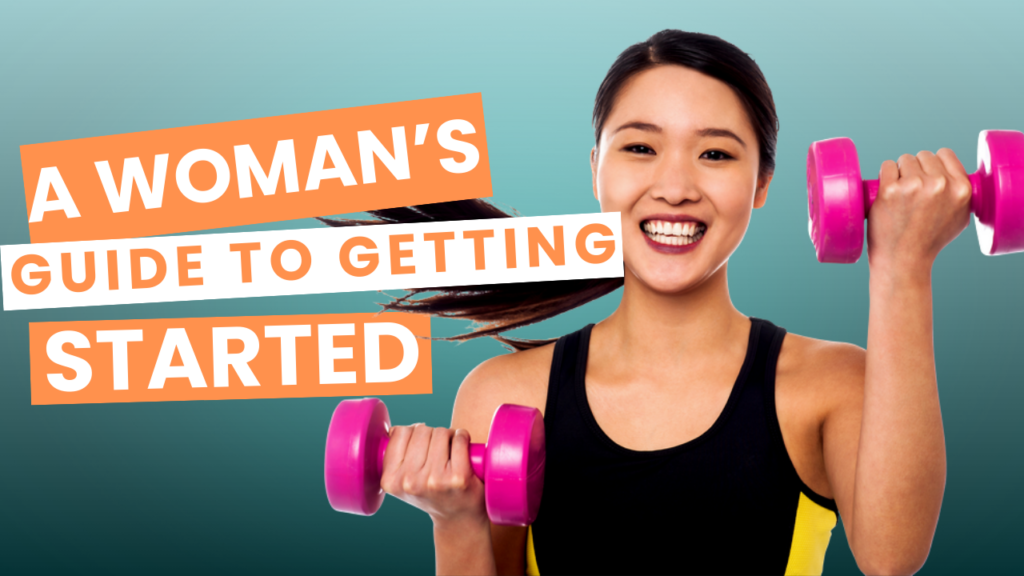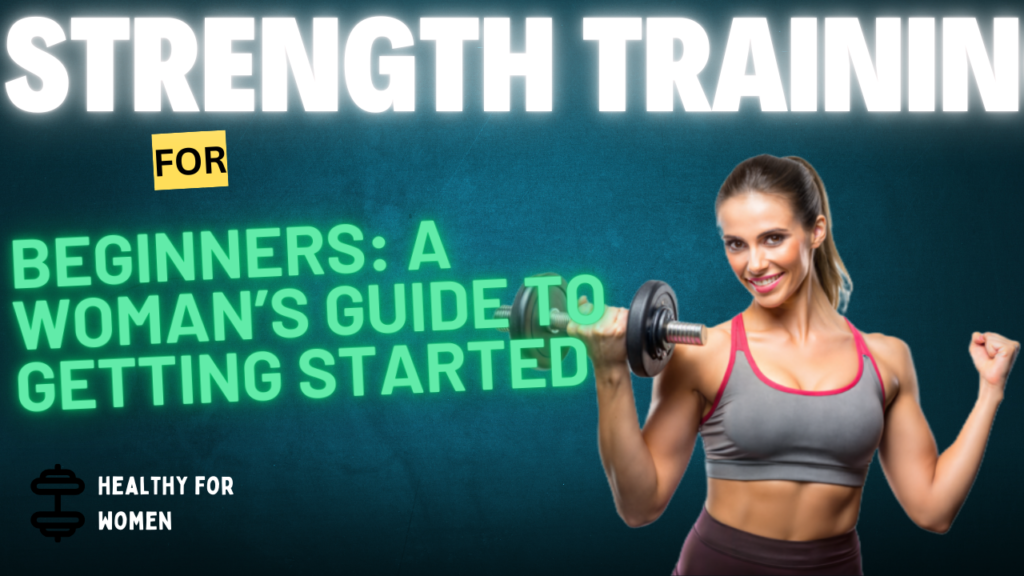In recent years, strength training for beginners has experienced a significant surge in popularity among women. This shift is not just about aesthetics; it’s about embracing a healthier, more empowered lifestyle.
Strength training offers a myriad of benefits that extend beyond physical health, impacting confidence, longevity, and overall well-being. Whether you’re looking to improve your health, boost your self-esteem, or simply feel more capable in your daily life, strength training is an excellent place to start.
Why Strength Training is Essential for Women
Strength training is no longer seen as a male-dominated activity. It’s now recognized as a vital component of a woman’s fitness routine, providing numerous health benefits that are unique to women.
The Benefits of Strength Training for Women’s Health

Strength training is crucial for maintaining and improving women’s health in several ways:
- Improved Bone Density: As women age, particularly during menopause, they experience a decline in estrogen levels, which can lead to reduced bone density and an increased risk of osteoporosis. Strength training helps stimulate bone growth, reducing the risk of fractures and osteoporosis by activating bone-forming cells28.
- Metabolism and Hormonal Balance: Building muscle through strength training boosts metabolism, helping women maintain a healthy weight and manage hormonal changes more effectively. This is particularly beneficial during menopause, when metabolic slowdowns are common6.
- Reduced Risk of Chronic Diseases: Regular strength training can lower the risk of chronic diseases such as heart disease, diabetes, and certain cancers by improving cardiovascular health and insulin sensitivity16.
RELATED ARTICLE: HIIT workouts for fat loss
Debunking Myths About Women and strength training for beginners
One of the most common misconceptions about strength training is that it makes women bulky. However, this is far from the truth. Women typically do not produce enough testosterone to build significant muscle mass like men. Instead, strength training enhances body composition by increasing lean muscle, which can improve overall femininity and confidence5.
Getting Started with Strength Training
Starting a strength training journey can seem daunting, but with the right approach, it can be both enjoyable and rewarding.
Setting Realistic Goals for Strength Training

When beginning strength training, it’s essential to set both short-term and long-term goals. Short-term goals might include mastering proper form for exercises or increasing the weight used over time. Long-term goals could involve achieving specific strength milestones or improving overall health markers like blood pressure or body composition.
Essential Equipment for Beginners
You don’t need a lot of equipment to start strength training for beginners women. Here are some essentials for beginners:
- Dumbbells: Versatile and easy to use for a variety of exercises.
- Resistance Bands: Portable and great for traveling or home workouts.
- Kettlebells: Useful for dynamic movements and full-body exercises.
- Bodyweight Exercises: Ideal for those who prefer no equipment or are just starting out.
How Often Should Women Strength Train?
Ideally, women should aim to strength train 2–4 times per week. This allows for adequate rest days, which are crucial for muscle recovery and growth. Balancing strength training with rest ensures that you avoid overtraining and prevent injuries.
Strength Training Exercises for Beginners
Here are some foundational exercises to get you started:
Foundational Lower-Body Exercises
- Squats: Works multiple muscle groups in the legs. Start with bodyweight or light weights and focus on proper form.
- Lunges: Targets legs and glutes. Use a shorter stride if you’re new to lunges.
- Glute Bridges: Excellent for strengthening glutes. Can be modified by using a resistance band.
Upper-Body Strength Training Basics
- Push-ups: Works chest, shoulders, and triceps. Start on knees if full push-ups are challenging.
- Dumbbell Rows: Targets back and arms. Use lighter weights to focus on form.
- Overhead Presses: Works shoulders and triceps. Start with lighter weights.
Core-Strengthening Moves
- Planks: Engages core muscles. Start with shorter holds and increase time as you build strength.
- Dead Bugs: Targets transverse abdominis muscles. Use a slow and controlled movement.
- Bird Dogs: Works core and improves balance. Focus on maintaining a straight line from head to heels.
Mastering Proper Form and Safety
Proper form is crucial to avoid injuries and ensure effective workouts.
Common Mistakes in Strength Training (And How to Avoid Them)
- Poor Posture: Maintain a straight back and engage core muscles during exercises.
- Lifting Too Heavy Too Soon: Gradually increase weights as you build strength.
- Neglecting Warm-ups: Always warm up before starting your workout to prevent muscle strains.
Tips to Prevent Injuries During Strength Training
- Warm-ups and Cool-downs: Essential for preventing muscle strains and improving flexibility.
- Progressive Overload: Gradually increase weight or reps over time to challenge muscles without risking injury.
- Listen to Your Body: Rest when needed and avoid pushing through pain.
Nutrition and Recovery for Strength Training

Nutrition and recovery are just as important as the training itself.
Fueling Your Body for Strength Gains
- Protein Intake: Essential for muscle repair and growth. Aim for 1.2 to 1.6 grams of protein per kilogram of body weight daily.
- Balanced Meals: Include complex carbohydrates, healthy fats, and lean proteins in your diet.
- Hydration Tips: Drink plenty of water throughout the day to stay hydrated.
The Role of Rest and Recovery
- Sleep: Aim for 7–9 hours of sleep per night to aid in muscle recovery.
- Active Recovery: Engage in light activities like walking or yoga on rest days.
- Listen to Your Body: Allow for extra rest if you feel fatigued or sore.
Creating Your First Strength Training Routine
Here’s a sample 4-week beginner workout plan:
Sample 4-Week Beginner Workout Plan
Here’s a sample 4-week beginner workout plan for women focusing on strength training. This plan includes a mix of exercises to target different muscle groups and can be adjusted based on your fitness level and goals.
Week 1: Introduction to Strength Training
First day: Full Body Workout
- Warm-Up: 5 minutes of light cardio (jogging in place, jumping jacks).
- Bodyweight Squats: 3 sets of 8 reps.
- Push-ups: 3 sets of 8 reps (modify on knees if needed).
- Glute Bridges: 3 sets of 8 reps.
- Plank: Hold for 30 seconds.
- Cool-Down: 5 minutes of stretching.
Second day: Upper Body Focus
- Warm-Up: 5 minutes of light cardio.
- Dumbbell Rows: 3 sets of 8 reps.
- Dumbbell Shoulder Press: 3 sets of 8 reps.
- Tricep Dips (using a chair): 3 sets of 8 reps.
- Cool-Down: 5 minutes of stretching.
Third day: Lower Body Focus
- Warm-Up: 5 minutes of light cardio.
- Lunges: 3 sets of 8 reps per leg.
- Calf Raises: 3 sets of 12 reps.
- Leg Raises (lying on your back): 3 sets of 12 reps.
- Cool-Down: 5 minutes of stretching.
Fourth day: Rest Day
- Optional Light Cardio: 20 minutes of walking or light jogging.
Fifth day: Core Focus
- Warm-Up: 5 minutes of light cardio.
- Plank: Hold for 45 seconds.
- Russian Twists (using a light dumbbell): 3 sets of 12 reps.
- Bird Dogs: 3 sets of 12 reps.
- Cool-Down: 5 minutes of stretching.
Day 6 & 7: Rest Days
Week 2: Building Strength
First day: Full Body Workout
- Warm-Up: 5 minutes of light cardio.
- Goblet Squats (using a light dumbbell): 3 sets of 10 reps.
- Push-ups: 3 sets of 10 reps.
- Glute Bridges: 3 sets of 10 reps.
- Plank: Hold for 45 seconds.
- Cool-Down: 5 minutes of stretching.
Second day: Upper Body Focus
- Warm-Up: 5 minutes of light cardio.
- Dumbbell Rows: 3 sets of 10 reps.
- Dumbbell Shoulder Press: 3 sets of 10 reps.
- Tricep Dips (using a chair): 3 sets of 10 reps.
- Cool-Down: 5 minutes of stretching.
Third day: Lower Body Focus
- Warm-Up: 5 minutes of light cardio.
- Lunges: 3 sets of 10 reps per leg.
- Calf Raises: 3 sets of 15 reps.
- Leg Raises (lying on your back): 3 sets of 15 reps.
- Cool-Down: 5 minutes of stretching.
Fourth day: Rest Day
- Optional Light Cardio: 20 minutes of walking or light jogging.
Fifth day: Core Focus
- Warm-Up: 5 minutes of light cardio.
- Plank: Hold for 60 seconds.
- Russian Twists (using a light dumbbell): 3 sets of 15 reps.
- Bird Dogs: 3 sets of 15 reps.
- Cool-Down: 5 minutes of stretching.
Day 6 & 7: Rest Days
Week 3: Increasing Intensity
First day: Full Body Workout
- Warm-Up: 5 minutes of light cardio.
- Goblet Squats (using a slightly heavier dumbbell): 3 sets of 12 reps.
- Push-ups: 3 sets of 12 reps.
- Glute Bridges: 3 sets of 12 reps.
- Plank: Hold for 60 seconds.
- Cool-Down: 5 minutes of stretching.
Second day: Upper Body Focus
- Warm-Up: 5 minutes of light cardio.
- Dumbbell Rows: 3 sets of 12 reps.
- Dumbbell Shoulder Press: 3 sets of 12 reps.
- Tricep Dips (using a chair): 3 sets of 12 reps.
- Cool-Down: 5 minutes of stretching.
Third day: Lower Body Focus
- Warm-Up: 5 minutes of light cardio.
- Lunges: 3 sets of 12 reps per leg.
- Calf Raises: 3 sets of 18 reps.
- Leg Raises (lying on your back): 3 sets of 18 reps.
- Cool-Down: 5 minutes of stretching.
Fourth day: Rest Day
- Optional Light Cardio: 20 minutes of walking or light jogging.
Fifth day: Core Focus
- Warm-Up: 5 minutes of light cardio.
- Plank: Hold for 90 seconds.
- Russian Twists (using a slightly heavier dumbbell): 3 sets of 18 reps.
- Bird Dogs: 3 sets of 18 reps.
- Cool-Down: 5 minutes of stretching.
Day 6 & 7: Rest Days
Week 4: Progressive Overload
First day: Full Body Workout
- Warm-Up: 5 minutes of light cardio.
- Goblet Squats (using a heavier dumbbell): 3 sets of 15 reps.
- Push-ups: 3 sets of 15 reps.
- Glute Bridges: 3 sets of 15 reps.
- Plank: Hold for 90 seconds.
- Cool-Down: 5 minutes of stretching.
Second day: Upper Body Focus
- Warm-Up: 5 minutes of light cardio.
- Dumbbell Rows: 3 sets of 15 reps.
- Dumbbell Shoulder Press: 3 sets of 15 reps.
- Tricep Dips (using a chair): 3 sets of 15 reps.
- Cool-Down: 5 minutes of stretching.
Third day: Lower Body Focus
- Warm-Up: 5 minutes of light cardio.
- Lunges: 3 sets of 15 reps per leg.
- Calf Raises: 3 sets of 20 reps.
- Leg Raises (lying on your back): 3 sets of 20 reps.
- Cool-Down: 5 minutes of stretching.
Fourth day: Rest Day
- Optional Light Cardio: 20 minutes of walking or light jogging.
Fifth day: Core Focus
- Warm-Up: 5 minutes of light cardio.
- Plank: Hold for 120 seconds.
- Russian Twists (using a heavier dumbbell): 3 sets of 20 reps.
- Bird Dogs: 3 sets of 20 reps.
- Cool-Down: 5 minutes of stretching.
Day 6 & 7: Rest Days
Adjustments and Tips:
- Progressive Overload: Gradually increase the weight or reps as you get stronger.
- Rest Days: Ensure you rest adequately to allow muscle recovery.
- Hydration and Nutrition: Stay hydrated and maintain a balanced diet to support muscle growth and recovery.
This plan is designed to be flexible and can be adjusted based on your fitness level and goals. Always listen to your body, and if you have any concerns, make sure to consult with a healthcare professional to ensure your safety and well-being.
How to Track Progress in Strength Training
- Journals: Record workouts and note improvements.
- Apps: Use fitness apps to track progress and set reminders.
- Photos: Take progress photos to visually track changes.
Overcoming Common Challenges
Staying motivated and adapting to busy schedules are key to maintaining a consistent strength training routine.
Staying Motivated in Strength Training
- Celebrate Small Wins: Acknowledge every small achievement.
- Find a Community: Join a gym or workout group for support.
- Vary Workouts: Change routines periodically to avoid boredom.
Adapting Strength Training for Busy Schedules
- Quick Home Workouts: Use bodyweight exercises or resistance bands for quick sessions.
- Time-Efficient Routines: Focus on compound exercises that work multiple muscle groups at once.
FAQs About Strength Training for Women
Here are some common questions answered:
- Can I Strength Train During Menstruation?
- Yes, strength training is generally safe during menstruation. However, listen to your body and adjust intensity based on how you feel.
- Will Strength Training Make Me Bulky?
- No, strength training typically does not make women bulky. It enhances muscle tone and body composition.
- How Long Does It Take to See Results?
- Results can vary, but noticeable improvements in strength and body composition often occur within 6–12 weeks of consistent training.
- Do I Need a Personal Trainer?
- Not necessarily. Online resources and workout plans can be very effective. However, a trainer can provide personalized guidance and motivation.
- Can I Do Strength Training at Home?
- Yes, many strength training exercises can be done at home using minimal equipment like dumbbells or resistance bands.
- Is Strength Training Suitable for All Ages?
- Yes, strength training is beneficial for women of all ages. It’s particularly important for older women to maintain muscle mass and bone density.
- How Often Should I Increase Weight or Reps?
- Gradually increase weight or reps as you feel stronger, typically every 2–4 weeks.
Conclusion
strength training for beginners is a powerful tool for women looking to improve their health, confidence, and overall quality of life. By understanding the benefits, debunking common myths, and starting with a well-structured routine, you can embark on a journey that will transform your body and mind. Whether you’re a beginner or looking to enhance your current routine, remember that every step forward is a step towards a stronger, healthier you.


One thought on “Strength Training for Beginners Women”